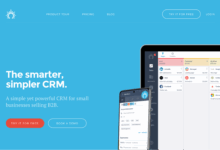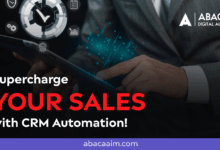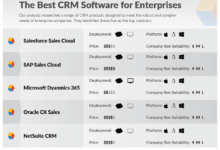Top Cloud-Based CRM Platforms: A Comprehensive Guide
Top Cloud-Based CRM Platforms are revolutionizing how businesses manage customer relationships. This guide delves into the core functionalities, benefits, and various platforms available, offering a comparative analysis to help you choose the best fit for your organization. We’ll explore leading options like Salesforce, Microsoft Dynamics 365, and HubSpot, examining their strengths, weaknesses, and suitability for different industries and business sizes. Understanding the nuances of integration, customization, and data security is crucial, and we’ll provide insights into these critical areas.
From freemium models to enterprise-level subscriptions, we’ll dissect pricing structures and highlight the key features that differentiate each platform. This comprehensive overview aims to equip you with the knowledge needed to make an informed decision, ultimately optimizing your customer relationship management and driving business growth.
Introduction to Cloud-Based CRM Platforms
Cloud-based Customer Relationship Management (CRM) platforms have revolutionized how businesses manage interactions with customers and prospects. They offer a flexible and scalable solution for organizations of all sizes, providing a centralized hub for managing crucial customer data and automating various processes. This allows businesses to improve efficiency, enhance customer relationships, and ultimately drive revenue growth.
Cloud-based CRMs store and manage all customer data—contact information, interactions, purchase history, and more—on remote servers maintained by the CRM provider. This contrasts sharply with on-premise solutions, which require businesses to purchase, install, and maintain their own servers and software.
Core Functionalities of Cloud-Based CRMs
A typical cloud-based CRM offers a range of core functionalities designed to streamline customer interactions and improve business operations. These typically include contact management (organizing and storing customer information), sales force automation (automating sales processes like lead tracking and opportunity management), marketing automation (automating marketing tasks like email campaigns and social media posting), customer service management (managing customer inquiries and support tickets), and reporting and analytics (providing insights into customer behavior and business performance). Many platforms also offer integration capabilities with other business applications, such as email marketing platforms and accounting software, further enhancing their utility.
Benefits of Cloud-Based CRMs over On-Premise Solutions
Cloud-based CRMs offer several significant advantages over traditional on-premise systems. Firstly, they are significantly more cost-effective, eliminating the need for expensive hardware, software licenses, and IT infrastructure maintenance. Secondly, they offer enhanced scalability and flexibility; businesses can easily adjust their CRM capacity to meet changing needs, adding or removing users as required. Thirdly, accessibility is improved; employees can access customer data and applications from anywhere with an internet connection, boosting productivity and collaboration. Finally, cloud-based systems usually receive automatic updates and security patches, reducing the burden on internal IT teams and enhancing security.
Types of Businesses Benefiting from Cloud-Based CRMs
The versatility of cloud-based CRMs makes them suitable for a wide range of businesses. Small businesses can leverage them to manage customer interactions efficiently, while large enterprises can use them to integrate and streamline operations across different departments. Specific examples include:
* E-commerce businesses: Managing customer orders, tracking shipments, and handling customer inquiries.
* Real estate agencies: Managing client leads, properties, and communication.
* Non-profit organizations: Managing donor relationships, tracking donations, and organizing volunteer activities.
* Healthcare providers: Managing patient records, scheduling appointments, and communicating with patients.
* Financial services firms: Managing client accounts, tracking transactions, and complying with regulatory requirements.
Comparison of Cloud-Based CRM Pricing Models
Different cloud-based CRM providers offer various pricing models, each with its own set of features and limitations. The table below compares key aspects of three common models: Freemium, Subscription (Basic), and Subscription (Enterprise).
| Feature | Freemium | Subscription (Basic) | Subscription (Enterprise) |
|---|---|---|---|
| Cost | Free (limited features) | Low monthly/annual fee | High monthly/annual fee |
| User Limits | Very limited | Limited number of users | Unlimited or very high user limits |
| Storage Capacity | Very limited | Limited storage space | High storage capacity |
| Features | Basic contact management, limited automation | Core CRM functionalities, basic automation | Advanced features, extensive automation, customizability, API access |
Top Cloud-Based CRM Platforms
Choosing the right cloud-based CRM platform is crucial for businesses of all sizes. The market offers a wide array of options, each with its own strengths and weaknesses. This section provides a comparative overview of three leading platforms: Salesforce, Microsoft Dynamics 365, and HubSpot, focusing on their user interfaces and overall capabilities.
User Interface Comparison of Salesforce, Microsoft Dynamics 365, and HubSpot
Salesforce, Microsoft Dynamics 365, and HubSpot each offer distinct user interfaces catering to different user preferences and technical proficiencies. Salesforce, known for its extensive customization options, presents a powerful yet potentially complex interface. Dynamics 365 boasts a more streamlined and intuitive design, generally considered easier to navigate for users less familiar with CRM systems. HubSpot, designed with marketing automation in mind, offers a clean and user-friendly interface, emphasizing ease of use and accessibility. The optimal choice depends heavily on the organization’s technical expertise and specific needs.
Strengths and Weaknesses of Salesforce, Microsoft Dynamics 365, and HubSpot
Salesforce: Strengths include its extensive functionality, robust app ecosystem, and unmatched market share, leading to a large and active community. Weaknesses include a steeper learning curve, potentially high costs, and the need for significant customization to fully utilize its capabilities.
Microsoft Dynamics 365: Strengths lie in its seamless integration with other Microsoft products, making it a natural fit for organizations already heavily invested in the Microsoft ecosystem. Its relatively intuitive interface and robust reporting features are also significant advantages. Weaknesses include a potentially less flexible customization compared to Salesforce and potentially higher initial setup costs depending on the chosen modules.
HubSpot: Strengths center around its user-friendly interface, strong marketing automation features, and a free CRM option. Its all-in-one approach, integrating marketing, sales, and service functionalities, appeals to smaller businesses. Weaknesses include potentially limited scalability for large enterprises and a less comprehensive feature set compared to Salesforce or Dynamics 365 in certain areas.
Successful Implementations Across Industries
Salesforce: Salesforce powers the CRM systems of numerous Fortune 500 companies across various sectors. For example, a global financial institution might leverage Salesforce’s robust security features and data analytics capabilities to manage customer accounts and mitigate risk. A large retail chain could utilize Salesforce’s commerce cloud to manage its online and offline sales channels.
Microsoft Dynamics 365: Companies with existing Microsoft infrastructure frequently choose Dynamics 365. A manufacturing company might use Dynamics 365 to manage its supply chain, track production, and optimize inventory. A healthcare provider could leverage Dynamics 365 to manage patient records, streamline appointments, and improve communication.
HubSpot: HubSpot’s ease of use and marketing features make it popular among smaller businesses and startups. A small marketing agency might use HubSpot to manage client relationships, track campaign performance, and automate email marketing. An e-commerce business could utilize HubSpot to manage its customer interactions, track sales, and improve customer service.
Feature, Pricing, and Target Audience Comparison
| Feature | Salesforce | Microsoft Dynamics 365 | HubSpot |
|---|---|---|---|
| User Interface | Highly customizable, powerful, but complex | Streamlined, intuitive, easy to navigate | Clean, user-friendly, emphasizes ease of use |
| Key Features | Sales Cloud, Service Cloud, Marketing Cloud, AppExchange | Sales, Customer Service, Marketing, Field Service | CRM, Marketing Automation, Sales Hub, Service Hub |
| Pricing | Variable, subscription-based, dependent on features and users | Variable, subscription-based, dependent on modules and users | Free CRM option available, paid plans for advanced features |
| Target Audience | Large enterprises, businesses requiring extensive customization | Businesses with existing Microsoft infrastructure, mid-sized companies | Small to medium-sized businesses, startups, marketing-focused organizations |
Integration and Customization Capabilities
A robust cloud-based CRM’s value extends far beyond its core contact management features. Its true power lies in its ability to seamlessly integrate with other essential business tools and adapt to the unique needs of each organization. Effective integration and customization are crucial for maximizing efficiency and achieving a holistic view of customer interactions.
The ability to integrate a CRM with other business applications significantly enhances its functionality and overall effectiveness. This interconnectedness streamlines workflows, eliminates data silos, and provides a more comprehensive understanding of customer behavior. For example, integrating marketing automation tools allows for targeted campaigns based on CRM data, while email marketing integration enables personalized communication directly from within the CRM system. This synergy between platforms empowers businesses to react to customer interactions more effectively and proactively.
CRM Integration with Marketing Automation Platforms
Integrating a CRM with a marketing automation platform (MAP) creates a powerful synergy, enabling businesses to automate marketing tasks, personalize customer journeys, and track campaign performance more effectively. This integration allows for the seamless flow of data between the two systems, providing a 360-degree view of the customer. For instance, a lead generated through a marketing campaign in the MAP can automatically be added to the CRM, complete with all relevant information. This eliminates manual data entry and ensures consistency across systems.
- Identify Integration Points: Determine which specific data points need to be shared between the CRM and MAP. This might include contact information, lead scores, campaign engagement data, and sales opportunities.
- Choose an Integration Method: Select an integration method, such as direct API integration, a pre-built connector, or a third-party integration platform. The best approach depends on the technical capabilities of both systems and the complexity of the integration.
- Map Data Fields: Carefully map the corresponding data fields between the CRM and MAP to ensure data accuracy and consistency. This step requires careful planning to avoid data duplication or conflicts.
- Test and Refine: Thoroughly test the integration to identify and resolve any issues before fully deploying it. Monitor the data flow and make adjustments as needed to optimize performance.
- Monitor and Maintain: Continuously monitor the integration to ensure its effectiveness and address any emerging problems. Regular maintenance is essential for a smooth and reliable data flow.
Customization Options in Cloud-Based CRM Platforms
Many cloud-based CRM platforms offer extensive customization options to tailor the system to specific business requirements. These options range from simple configuration changes to complex custom development. This flexibility ensures that the CRM system can adapt to the unique needs of different businesses, regardless of size or industry. For example, a small business might customize its CRM to track specific sales metrics, while a larger enterprise might integrate it with a complex inventory management system.
Examples of CRM Customization
A retail company might customize its CRM to include specific fields for tracking customer purchase history, preferred payment methods, and loyalty program participation. This detailed customer data allows for targeted marketing campaigns and personalized customer service. A manufacturing company, on the other hand, might customize its CRM to integrate with its production scheduling system, providing real-time visibility into order fulfillment and customer delivery timelines. This level of integration ensures accurate order tracking and efficient communication with customers. A non-profit organization could customize its CRM to track volunteer hours, donor contributions, and event participation, providing valuable insights into their operational efficiency and community engagement.
Data Security and Privacy in Cloud-Based CRMs
The security and privacy of customer data are paramount concerns when choosing a cloud-based CRM. Leading providers invest heavily in robust security measures to protect this sensitive information, adhering to various industry compliance standards. Understanding these measures and implementing best practices is crucial for businesses leveraging cloud CRMs.
Security Measures Employed by Leading Cloud-Based CRM Providers
Leading cloud CRM providers typically employ a multi-layered security approach. This often includes data encryption both in transit (using protocols like HTTPS) and at rest (using strong encryption algorithms). They also utilize firewalls, intrusion detection systems, and regular security audits to identify and mitigate potential vulnerabilities. Access controls, such as role-based permissions, restrict access to sensitive data based on employee roles and responsibilities. Regular software updates and patching are crucial to address known vulnerabilities promptly. Many providers also leverage advanced threat detection technologies, such as machine learning, to identify and respond to sophisticated cyber threats in real-time. For example, Salesforce, a leading CRM provider, invests heavily in security infrastructure and employs a team of security experts dedicated to protecting customer data.
Compliance Standards Adherence
Cloud-based CRM platforms are often designed to comply with various data privacy regulations, including the General Data Protection Regulation (GDPR) in Europe and the California Consumer Privacy Act (CCPA) in the United States. Compliance involves implementing technical and organizational measures to ensure the lawful processing of personal data, including providing data subjects with control over their data. This can include features like data subject access requests (DSAR) tools and consent management capabilities. Adherence to these standards demonstrates a commitment to data protection and helps businesses avoid potential penalties and reputational damage. For example, a CRM provider might offer tools that allow users to easily export or delete their data, complying with GDPR’s “right to be forgotten” principle.
Best Practices for Ensuring Data Security When Using Cloud-Based CRM Systems
Implementing strong password policies and multi-factor authentication (MFA) is crucial to prevent unauthorized access. Regularly reviewing and updating user permissions ensures only authorized personnel access sensitive data. Data loss prevention (DLP) tools can monitor and prevent sensitive data from leaving the organization’s control. Employee training on security best practices and phishing awareness is essential to minimize human error, a significant source of security breaches. Regular backups of CRM data are critical to ensure business continuity in case of data loss or system failures. Finally, choosing a reputable CRM provider with a strong security track record and transparent security practices is paramount.
Potential Security Risks and Mitigation Strategies
Several security risks are associated with cloud-based CRMs. Data breaches, resulting from unauthorized access, are a major concern. Mitigation involves implementing robust security measures, as discussed above, including encryption, access controls, and regular security audits. Data loss due to system failures or accidental deletion is another risk; regular backups and disaster recovery plans are crucial mitigation strategies. Third-party vulnerabilities, arising from integrations with other cloud services, require careful vendor selection and security assessments. Unauthorized data access by employees can be mitigated by implementing strong access controls and regular security awareness training. Finally, the potential for regulatory non-compliance requires understanding and adhering to relevant data privacy regulations and employing tools to facilitate compliance.
Choosing the Right Cloud-Based CRM Platform
Selecting the ideal cloud-based CRM requires careful consideration of various factors to ensure a seamless integration with your business operations and a positive return on investment. A poorly chosen system can lead to inefficiencies, data silos, and ultimately, hinder business growth. This section outlines a structured approach to selecting the right CRM for your specific needs.
Factors to Consider When Selecting a Cloud-Based CRM
Several key factors influence the choice of a cloud-based CRM. Understanding these factors allows businesses to make informed decisions aligned with their goals and resources.
- Business Size and Structure: Small businesses might find simpler, more affordable platforms sufficient, while larger enterprises require robust systems with advanced features and scalability. The organizational structure, including sales processes and departmental needs, also impacts the CRM’s required functionality.
- Budget: CRM platforms vary significantly in pricing, from affordable monthly subscriptions to enterprise-level solutions with substantial upfront costs. It’s crucial to establish a clear budget and evaluate pricing models (subscription-based, per-user, etc.) before making a selection.
- Specific Business Needs: The core functionalities required depend on the business’s specific needs. Sales-focused businesses might prioritize features like lead management and sales pipeline tracking, while customer service-oriented businesses may focus on ticketing systems and case management. Marketing automation, integration with other software, and reporting capabilities are also critical considerations.
- Integration Capabilities: Seamless integration with existing software (e.g., email marketing platforms, accounting software) is essential for efficient data flow and streamlined workflows. Assess the CRM’s API capabilities and available integrations to ensure compatibility with your current tech stack.
- Scalability and Flexibility: The chosen CRM should be able to adapt to your business’s growth. Consider whether the platform can handle increasing data volume, user accounts, and evolving business requirements without significant disruption.
- User-Friendliness and Training: A user-friendly interface minimizes the learning curve for employees and ensures efficient adoption. Consider the availability of training resources and support to facilitate a smooth transition.
A Decision-Making Framework for CRM Selection
A structured approach to CRM selection ensures a well-informed decision. This framework considers business size, budget, and specific needs.
- Define Business Requirements: Clearly articulate your business goals and the functionalities required from the CRM. This includes identifying key performance indicators (KPIs) that the CRM will help track and improve.
- Assess Budget Constraints: Determine the maximum budget allocated for the CRM, including implementation, training, and ongoing maintenance costs. Consider different pricing models and their implications on your overall budget.
- Evaluate CRM Platforms: Based on the defined requirements and budget, research and shortlist potential CRM platforms. Compare features, pricing, and user reviews to identify the best fit.
- Conduct Proof-of-Concept (POC): If possible, conduct a POC with shortlisted platforms to test their functionality and usability within your specific environment. This allows for a hands-on evaluation before committing to a long-term contract.
- Select and Implement: Based on the POC results and overall evaluation, choose the CRM platform that best aligns with your business needs and budget. Implement the system, provide adequate training, and monitor its performance.
Examples of CRM Platform Suitability
Different CRM platforms cater to various business needs and sizes.
- Small Businesses (e.g., a startup bakery): A simpler platform like HubSpot CRM (free plan available) or Zoho CRM (affordable plans) might suffice, offering basic contact management, sales pipeline tracking, and email integration. These platforms are easy to use and require minimal technical expertise.
- Medium-Sized Businesses (e.g., a regional clothing retailer): Salesforce Sales Cloud or Microsoft Dynamics 365 could be suitable, offering more advanced features like marketing automation, customer service tools, and reporting dashboards. These platforms provide scalability to support business growth.
- Large Enterprises (e.g., a multinational corporation): Enterprise-level solutions like Salesforce Sales Cloud (Enterprise Edition) or SAP CRM are often necessary, offering comprehensive functionalities, advanced customization options, and robust security features to manage large volumes of data and complex business processes.
CRM Selection Process Flowchart
A visual representation of the CRM selection process can be helpful. Imagine a flowchart starting with “Define Business Needs,” branching to “Assess Budget,” then to “Research & Shortlist Platforms,” followed by “Conduct POC (if possible),” and finally culminating in “Select & Implement.” Each stage involves decision points and feedback loops, ensuring a thorough and iterative process. The flowchart visually emphasizes the importance of iterative evaluation and continuous refinement throughout the selection process.
Future Trends in Cloud-Based CRM
The cloud-based CRM landscape is in constant evolution, driven by advancements in technology and shifting business needs. Emerging trends are reshaping how businesses interact with customers, promising increased efficiency, personalized experiences, and deeper insights into customer behavior. These advancements are not just incremental improvements; they represent a fundamental shift in the capabilities and potential of CRM systems.
The integration of artificial intelligence (AI), machine learning (ML), and enhanced mobile accessibility are significantly impacting the future of cloud-based CRM, leading to more intelligent, proactive, and user-friendly systems. These technologies are fundamentally altering business operations and customer relationship management strategies across various industries.
AI-Powered Predictive Analytics and Automation
AI and ML are transforming CRM by enabling predictive analytics. These systems can analyze vast amounts of customer data to identify patterns and predict future behavior, such as churn risk or likelihood of purchase. This allows businesses to proactively address potential issues and personalize marketing efforts, leading to improved customer retention and increased sales. For example, a telecommunications company could use AI to identify customers likely to switch providers, allowing them to offer targeted retention deals before they leave. This proactive approach is far more effective than reacting to customer churn after it has occurred. Furthermore, AI-powered automation streamlines repetitive tasks like lead qualification and data entry, freeing up sales and marketing teams to focus on higher-value activities.
Enhanced Mobile Accessibility and User Experience
Modern businesses operate in a mobile-first world. Cloud-based CRMs are adapting to this reality by offering increasingly robust mobile applications. These applications provide sales teams with real-time access to customer information, enabling them to respond quickly to inquiries and close deals more efficiently. For instance, a field service technician can access a customer’s service history and relevant documentation directly from their mobile device, ensuring they have all the necessary information to complete the job effectively. The improved user experience, with intuitive interfaces and personalized dashboards, enhances user adoption and overall productivity.
The Impact on Business Operations and Customer Relationship Management
The integration of AI and enhanced mobile accessibility significantly improves business operations and customer relationship management. AI-driven automation reduces manual effort, freeing resources for strategic initiatives. Predictive analytics allows for proactive customer engagement, leading to improved customer satisfaction and loyalty. Enhanced mobile accessibility empowers sales teams and improves responsiveness to customer needs. This combined effect results in increased efficiency, improved decision-making, and stronger customer relationships. For example, a retail company could use AI to personalize product recommendations based on individual customer preferences, leading to increased sales and a more positive customer experience. The seamless integration of these advancements into mobile CRM applications ensures that these benefits are readily available to employees regardless of their location.
Predictions for the Future of Cloud-Based CRM
In the next five years, we can expect even more sophisticated AI integration in cloud-based CRMs. This will lead to hyper-personalization of customer interactions, with CRM systems anticipating customer needs and providing tailored experiences. The increasing use of natural language processing (NLP) will enable more natural and intuitive interactions between businesses and customers. We will also see greater integration between CRM and other business applications, creating a more holistic view of the customer and streamlining workflows. Furthermore, the rise of the metaverse and other immersive technologies could lead to new ways of engaging with customers within the CRM system. For example, imagine virtual showrooms or interactive customer service experiences within a CRM platform. This could fundamentally change how businesses interact with their customers, moving beyond traditional methods of communication.
Artificial Intelligence’s Transformation of CRM in the Next Five Years
In the next five years, AI will fundamentally change how businesses use CRM. AI-powered chatbots will handle a significant portion of customer service inquiries, providing instant support and freeing human agents to focus on more complex issues. AI will also play a crucial role in lead scoring and qualification, identifying high-potential leads and prioritizing sales efforts. Predictive analytics will become even more sophisticated, allowing businesses to anticipate customer needs and proactively address potential problems. This will lead to a more proactive and personalized customer experience, enhancing customer satisfaction and driving business growth. For instance, a financial institution could use AI to detect fraudulent transactions in real-time, protecting customers and preventing financial losses. This level of proactive risk management would be impossible without the power of AI within the CRM system.
Outcome Summary
Selecting the right cloud-based CRM is a strategic decision that significantly impacts business efficiency and customer satisfaction. By carefully considering factors like business size, budget, specific needs, and future scalability, businesses can leverage the power of cloud-based CRM systems to streamline operations, improve customer engagement, and achieve sustainable growth. The information presented here provides a solid foundation for making an informed choice, enabling you to harness the transformative potential of these innovative platforms.





